
Since 1970, the planet’s wildlife populations have decreased by an average of 68 percent, according to the World Wildlife Fund’s 2020 Living Planet Report. Today’s extinction rate is hundreds, maybe even thousands of times higher than the normal baseline rate. The previous five mass extinction events wiped out 50 to 90 percent of all species on the planet. Earth is in the middle of its sixth mass extinction. But this time, human activity, or more accurately capitalism, is the driving factor.
Wildlife populations in Latin America and the Caribbean have suffered the largest losses, with an average population decline of 94 percent. Global freshwater species have also been devastated, declining an average of 84 percent. These drastic declines signal the grim future ahead for millions of species on the planet, humans included, if we don’t make efforts to change that fate now.
And it’s going to take more than simply planting trees and riding our bikes to protect the future. The problem is clearly bigger than any one of us can tackle alone. Protecting our future, and the future of millions of species on our planet, is going to take nothing less than a complete transformation of our society. We need a society driven not by the profits of a parasitic ruling class, but by our collective will to survive. This future is possible, but we’re going to have to fight for it.




